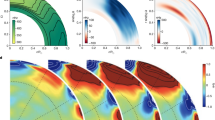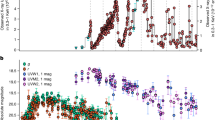Abstract
OBSERVATIONS on the optical object associated with Cyg X-2 (ref. 1) have shown that the system is a spectroscopic binary (for example, ref. 2), with one component a G star3, but the nature of the other component is not obvious. Kraft and Demoulin3 identified the G component from weak but definitely present G-type features, including the λ4226 line of Ca I, which they measured for radial velocities. By assuming an absolute visual magnitude of + 5.5 for the G star, they estimated the distance of Cyg X-2 to be 500 to 700 pc. This in turn, together with the X-ray flux observations, means that the X-ray luminosity is about 25 L⊙. As well as the G spectrum, broad Balmer absorption lines, of equivalent width appropriate for about type A8, and relatively sharp absorption lines of Ca II (H and K) are prominent. The profiles of the Balmer lines are unique4 in that they are very broad, yet show no wings of any kind. The widths are far too great to result from thermal Doppler motions, for hydrogen could not be neutral at the indicated temperature. Sofia5 has shown that all broadening mechanisms except mass motions (of the order of 103 km s−1) can be eliminated. A further unusual feature is the ratio of the strengths of the Balmer lines, with the high number lines relatively strong, Hβ quite weak, and Hα entirely absent or perhaps present weakly in emission2. Beyond the fact that they show binary motion, the most noteworthy feature of the radial velocity measures is their very large scatter and lack of repeatability. Although the radial velocities were determined in difficult conditions, so that the errors of measurement are much greater than normally expected, the scatter in the Balmer line velocities is far too large to be explained in this way. Within these uncertainties, however, we can say that there seem to be two velocity systems represented: that of Ca I and He II, and that of Ca II and the Balmer lines.
This is a preview of subscription content, access via your institution
Access options
Subscribe to this journal
Receive 51 print issues and online access
$199.00 per year
only $3.90 per issue
Buy this article
- Purchase on Springer Link
- Instant access to full article PDF
Prices may be subject to local taxes which are calculated during checkout
Similar content being viewed by others
References
Giacconi, R., Gorenstein, P., Gursky, H., Usher, P. D., Waters, J. R., Sandage, A., Osmer, P., and Peach, J. V., Astrophys. J. Lett., 148, L129 (1967).
Burbidge, E. M., Lynds, C. R., and Stockton, A. N., Astrophys. J. Lett., 150, L95 (1967).
Kraft, R. P., and Demoulin, M. H., Astrophys. J. Lett., 150, L183 (1967).
Kristian, J., Sandage, A., and Westphal, J. A., Astrophys. J. Lett., 150, L99 (1967).
Sofia, S., Astrophys. Lett., 2, 173 (1968).
Lynds, C. R., Astrophys. J. Lett., 149, L41 (1967).
Peimbert, M., Spinrad, H., Taylor, B. J., and Johnson, H. M., Astrophys. J. Lett., 151, L93 (1968).
Sklovsky, I. S., Astrophys. J. Lett., 148, L1 (1967).
Sofia, S., Astrophys. J. Lett., 149, L59 (1967).
Cameron, A. G. W., and Mock, M., Nature, 215, 464 (1967).
Kopal, Z., Close Binary Systems, 516 (Wiley and Sons, New York, 1959).
Author information
Authors and Affiliations
Rights and permissions
About this article
Cite this article
WILSON, R., SOFIA, S. Model of Cygnus X-2. Nature 223, 1350–1351 (1969). https://doi.org/10.1038/2231350a0
Received:
Revised:
Issue Date:
DOI: https://doi.org/10.1038/2231350a0
Comments
By submitting a comment you agree to abide by our Terms and Community Guidelines. If you find something abusive or that does not comply with our terms or guidelines please flag it as inappropriate.



